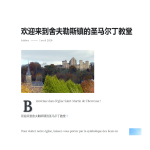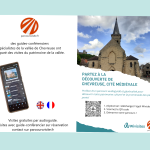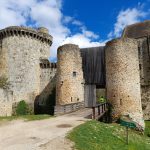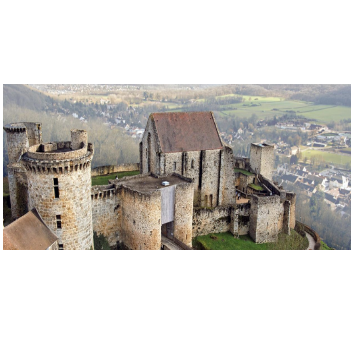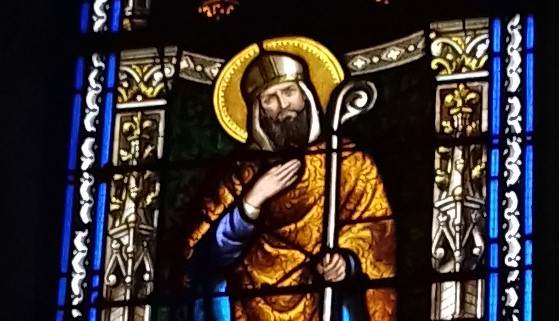You are going to take a 3 to 5 kilometer hiking or bike riding circuit to discover various and exquisite landscapes of the region, from the RER Station Saint-Rémy-lès-Chevreuse to the enchanting Château de Breteuil
After following old preserved rail tracks in the woods, you will walk along world famous Coubertin estate, a former priory and astonishing large pieces of sandstone before heading across the Boulay les Troux plateau where a Commandery of Templars was built in the middle ages.

From then, through lush meadows the track will lead you gently to the magnificent Château de Breteuil and its enchanting fairy tales scenes. Built on the site of a medieval fortress, it dates back to the 17th century.
****
***********
****
After leaving the RER station, you can go on the left. Look at the little red house ! It is the former gatekeeper’s place, where you will find the tourist office and electric bicycles for rent.

The railway station in Saint-Rémy was first built in 1867. Until 1939, passenger and freight trains operated as far as Limours.
***
*******
***
Follow the remaining railtracks; they cut the Coubertin estate in two!
On the right, its château, first built in 1696 by Bernard Fredy de Coubertin, was restored in the 18th century and reshaped in 1896 with a rooftop terrace and a lounge area.
The 17th century farm buildings and the impressive dovecote are next to the chapel.

What an interesting family!
– Bonaventure Julien de Frédy, Baron de Coubertin (1788-1871), senior official of Emperor Napoleon I in Germany and high-ranking officer in King Louis XVIII army, was Mayor of Saint-Rémy.
– His son, the artist Charles de Coubertin, painted the altarpiece in the Church of Saint-Rémy which is now classified as a National Treasure.
– His grandson, Pierre de Coubertin, the father of modern olympics, founded the IOC (International Olympic Committee) in 1894, established the Olympic Charter.

– Pierre’s nieces, baroness Yvonne de Coubertin and her sisters, inherited the château.
As a philanthropist, Yvonne, together with sculptor Jean Bernard, set up the world famous Coubertin foundation in the château to preserve the practice of traditional buildings, arts and trades in a spirit of compagnonnage. It is still active with its renowned Ateliers Saint-Jacques (foundry, woodworking, stone cutting and metal and iron work). Among many other works of rare beauty, they have restored the gates of the Château de Versailles and the statue of Saint Michael the Archangel, the highest point of the Mont Saint Michel.
In the foundation park are sculptures of Rodin, Bourdelle, Bernard, Pan, throughout the amazing Jardin des Bronzes (Bronzes garden).
Baroness Yvonne de Coubertin had other charities, especially a boarding house for young girls to which she was much dedicated..
*
***
*
As you continue, you will walk past the Domaine Saint-Paul.
This priory, dating back to the Middle Ages, was sold as a ‘national property’ during the French Revolution. It changed hands several times until it was bought by Honoré Ditte in 1826; M.Ditte was one of the founding members of the ‘Le Phenix’ Insurance company.

A beautiful and romantic place of leisure, numerous artists enjoyed coming to the ‘Domaine Saint Paul’ such as Queen Marie-Antoinette’s favorite painter Elisabeth Vigée Lebrun, painters Jean-Baptiste Ysabey and Gustave Moreau and writers as famous as Victor Hugo or George Sand!
Léo Delibes’s ballets, ‘Coppelia’ and ‘La Source’, were inspired by the Montabé creek which runs down the center of the estate.
In 1957, the Domaine Saint Paul was finally developped into a Technical Center with new buildings drawn by architect Eugene Wassermann.

Nowadays, the Domaine Saint-Paul is a multi-use campus with a full program of seminars and cultural activities, a hotel with 89 rooms and a nice restaurant with a panoramic view of the lake.
*
***
*
Part of the estate is a sandstone quarry which has been operated during 50 years, from 1851 onwards. With two sandstone layers separated by 2 meters of sand, the average monthly output was 8500 blocks, sent to Paris by road and then by rail.

Millstone was also exploited either in the quarry or directly in the woods and the fields. In the 19th and early 20th century, families building their home would come with their cart and dig to find millstones, thus leaving shell holes throughout the woods of the estate.

Further west, suddenly, you see an astonishing tower, building 18. First dedicated to mysterious experiments in fluid dynamics, it was called the ‘Laboratoire vertical des fluides’ otherwise known as a drop tower (the vertical lab for liquids). Nowadays, the tower is the perfect spot for a base station of telephone network and firemen training!

*
***
*
Go on this path, walk past a second gatekeeper’s house and follow either the remaining rails (GR11) or the road up to Boullay-les-Troux.
At the entrance of the village is a big farm with a tower, the remains of a medieval Commandery of Templars.
In 1190, Simon de Chevreuse, Lord and master of these lands, answered the call for a holy crusade to Jerusalem. Before leaving, he gave the Knights of the Temple the village called Booleium, thus merging with the Commandery of Templars in Ville-Dieu-lès-Maurepas.
In the XVIIth century, when the Abbey of Port Royal was closed, some nuns moved to the Château de Troux, next to the church.
*
***
*
Once you have reached the school and the city hall of Boullay, you can either continue along GR11 through the fields or follow the ‘route d’Herbouvilliers’; you have reached a plateau with a heavy soil which contains a lot of red clay. Nowadays, you are surrounded by rich wheat, rapeseed and corn fields but, until World War I, those lands were poorly drained and used as pasture for sheep and goats.
After the deadly war, most farmers did not come back to those desolate lands, either killed or hired as day-workers in Paris. It is then that dutch farmers arrived, with drainage techniques which turned a barren plateau into rich and fertile grain lands.
Today, most farmers in the neighbourhood still have a flemish name.
Further north is the Doinvilliers farm which dates back to the middle ages and westward are the woods of the Château de Méridon.
*
***
*
Very little was left of the medieval castle when Pierre de Braga, bank manager of the Crédit Foncier, bought the Méridon estate in 1882. He had the château rebuilt in a Neo-Renaissance style surrounded by a moat on the site of the former castle.

The Breteuil family bought the estate in 1904 and, with the help of famous French landscape architects Henri and Achille Duchêne, redesigned the gardens to provide the château with a majestic setting.
Rented for a few years to American ambassador in Paris Henry White, who took part in the discussions about the Treaty of Versailles, Méridon was finally rented then sold to the Dutch government to house soldiers dealing with the traumas of war.
In 1946, the premises were granted to a Dutch association to train farmers who wanted to settle in France.
Finally, in 2003, Méridon was sold again and turned into a centre for seminars and weddings.
*
***
*
As you continue your walk, farther south you notice unusual round antennas: they belong to the DGSI, the french secret services.
Herbouvilliers is one of the hamlets of Choisel, with old farm houses and a waterer.

*
***
*

In Herbouvilliers, if you are cycling you can either take ‘rue de l’abreuvoir’ (waterer street) or, if you want to take a 2 kilometers shortcut, follow walkers and take the ‘impasse des Tilleuls’ (lime-trees dead end) and continue on the footpath leading to the entrance of the ‘Château de Breteuil’.

You will walk past a milestone marked ‘Bévilliers’, the name of the ancient medieval castle and gallo-roman villas which were built on the site of the Château de Breteuil.
The farms’ names, Magnanerie and Fillolière, remind us that the breeding of silkworms was a major activity until the early 20th century.
Walk around the Fillolière farm, turn right and go along the road lined with beautiful poplar trees until you reach the entrance of the enchanting Château de Breteuil.

Château de Breteuil: open for visits all year round.
Guided tours of the Château begin at 2 :30 pm all year around, and the last one is at 5 :30 pm. Additional visits at 11 :30 am on sundays, public holidays and during vacations for schools in the Paris region.
Article « from Saint-Rémy to Breteuil » FD-SW 2.9.2020
photos et doc HB IGN Breteuil Domaine St-Paul..
.
